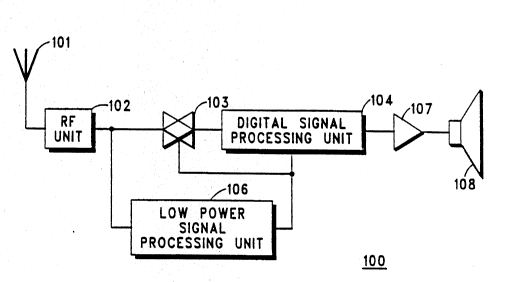Note: Descriptions are shown in the official language in which they were submitted.
WO 90/116~2 2 0 ~ ~ 5 ~ 9 PCr~USgO/01336
DSP BASED RADIO WITH DIMINISHED
POWER REQUIREMENTS
1 0
Te.~h~cal Fie~
This invention relates generally to radios, and more
particularly to radios that include a digital signal processor.
1 5
Back~rQunsi Art
Radios generally function to receive broadcast signals.
Usually~ the user of a radio will not be interested in all of the signals
20 that are broadcas~ on a communication resource (such as a
particular frequency or a particular TDM time slot). Since many
broadcast signals of interest include an identifying signal or other
identifying indicia, many radios include a signal processor that
examines the received broadcast signal to determine the presence of
2~ the identifying signal. If present, the radio can be further enabled to
render the broadcast signal audible! visible, or otherwise as
appropriate for that particular broadcast signal.
For example, some radios remain squelched unless a carrier
can be sensed on a particular monitorsd communication resource.
30 Other broadcast signals include special identifying signals, such as
tone signals or subaudible digital signals, that the radio can
recognize and respond to. Yet other signals of interest can be
~ l ;
WO 90/11652 PCI'/U~;90/01336
~045~1~
prefaced with a specific identifying pr~3amble, such as an ID for the
intended radio.
In order to expand the capabiiities and flexibility of radios,
digitizers and digital signal processors (DSPs) have been used.
These processors typically receive digitized received signals. Further
processing of the signal, equivalent to IF and discriminator
processing, then occurs in the DSP in a digital manner. The resultant
signal can then be converted into analog form and processed further
as appropriate. For example, the resultant signal may be rendered
10 audible in the case of a voice transmission.
DSPs, however, consume a significant amount of power when
operating. This becomes a particular problem when seeking to use a
DSP in a portable radio with limited power resources. DSP power
consumption becomes of particular concern when the DSP operates
15 both in the presence and absence of a broadcast signal of interest.
Typically, the DSP must operate even in the absence of a broadcast
signal of interest because the DSP itself aids in detecting the
presence of a broadcast signal of interest. Unless the broadcast
signals of.interest occur at known times, the DSP must remain active
20 in order to detect the signal when it occurs.
Surrlrn~ of the Invention:
This invention allows a DSP to be used in a radio while
25 avoiding the necessity of continuous DSP operation.
The invention includes general!y two signal processing units,
the first includes the DSP and the second includes a processing unit
having lesser capabilities and smaller power requirements. The DSP
based signal processing unit functions ~o fully process broadcast
30 signals of interest. The low power processing unit functions to detect
the presence of a broadcast signal of interest, and upon detecting
WO 90/1165~ 2 0 ~ ~ ~ 1 9 Pcr/vs9o/ol336
such a signal, the low power processing unit enables the DSP
based processing unit to begin functioning.
Through use of this invention, the high power requirements of
the DSP based processing unit are necessitated only when a
5 broadcast signal of interest exists. Otherwise, a lower power
broadcast signal of interest detection mechanism monitors the
communication resource.
Brief Descri~Qn of the Drawin~;
1 0
Fig. 1 comprises a block diagram depiction of the invention;
Fig. 2 comprises a block diagram depiction of the low power
signal processing unit.
15 Best MQsle for Carrying out the InventiQn:
Referring to Fig. 1, a radio (100) includes generally an
antenna (101) for receiving broadcast signals and an RF unit (102)
for appropriately processing the received broadcast signals. The
20 received signals are then passed to a low power signal processing
unit (106) and also through an appropriate gate (103) to a digital
signal processing unit (104) (the lattertypically including a DSP such
as the Motorola 560Q0 and a microprocessor to control the DSP).
The output of the digital signal processing unit (104) then couples to
2~ an appropriate amplifier (107) and speaker (108) or other output
devices as appropriate to the type of message received.
With reference to Fig. 2, the low power signal processing unit
(106) includes an appropriate IF unit (201 ) for receiving the output
signal from the RF unit (102), a discriminator (202) for processing the
30 IF unit (201) output to aid in recovering the original modulating
signal, and a processing unit (203) for examining the recovered
signal and determining whether an appropriate identifying signal is
WO 90/11652 ~ ` PCI'/~JS~0/01336
9 ~ .
present. The processing unit (203) could be any relatively simple and
low power device, such as a Motoro!a MC6303 processor.
Upon detecting the presence of a broadcast signal of interest,
the processing unit (203) of the low power signal processing unit
5 provides a signal to the gate (103), thereby allowing the RF signal to
be provided to the digital signal processing unit (104). At the same
time, the processing unit (203) provides an enable signal to the
digital signal processing unit ~104) ~o activate that unit and cause it to
begin processing the incoming signal.
So configured, the digital signal processing unit will operate
only when a broadcast signal of interest can be detected. Otherwise,
the low power signal processing unit will moni~or the received
broadcast signals and control the activation of the digital signal
processing unit as a function of the presence and absence of a
1 5 broadcast signal of interest.
/
